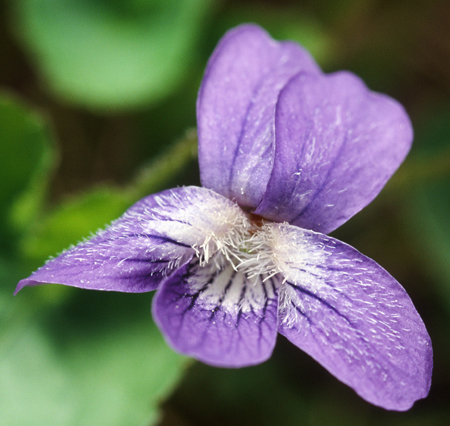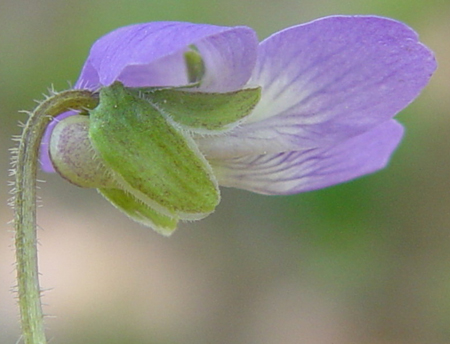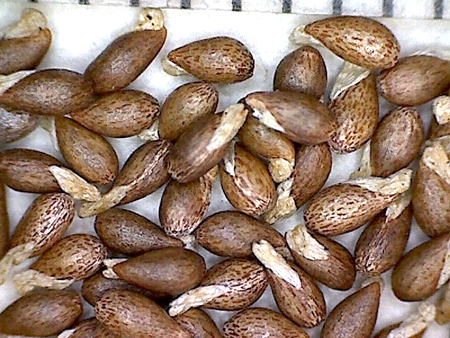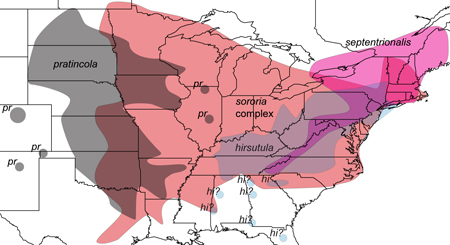Viola septentrionalis Greene [species complex]
Common names:
Northern Blue Violet
Synonyms:
See subordinate taxa.
Subordinate taxa belonging to this species:
Viola septentrionalis Greene [sensu stricto]
Viola septentrionalis [Upper Midwest variant]
Description:
Acaulescent rosulate perennials from thick rhizome, ≤ 29 cm tall; foliage and peduncles gray-green, upper surface of leaf blades darker green than lower, lower commonly tinged with purple, sparsely to densely hirsute; stipules free, irregularly glandular-fimbriate; leaves ascending to spreading, leaf blades undivided, largest ≤ 98 × 89 mm, narrowly or broadly ovate in chasmogamous flower, broadening to deltate-reniform in fruit, margins serrate (occasionally weakly so), densely ciliate with spreading hairs (these often long), apex acute to obtuse or rounded; chasmogamous peduncle held above the leaves early in fl, among the leaves later; chasmogamous flower ≤ 22 mm; calyx glabrous or pubescent, sparsely to densely ciliate nearly or fully to apex (hairs often long); lowest sepals broadly ovate-lanceolate to ovate and obtuse to rounded, or sometimes ovate-triangular and sharply acute; auricles prominent and entire to erose, elongating to 3 mm in fruit; corolla blue to purple, throat white; spur short-globose; lateral petals densely bearded with filiform to narrowly linear hairs, spurred petal densely bearded; chasmogamous capsule green; cleistogamous flowers produced after chasmogamous, on prostrate peduncle much shorter than petioles and arching just before capsule dehiscence; cleistogamous capsule 5–8 mm, green drying tan with purple spots or blotches, glabrous; seeds 1.2–2.3 × 0.8–1.2 mm, light-medium brown to dark brown, unspotted (eastern and northern populations) or with small weak darker streaks or spots (Upper Midwest populations); 2n=54.
Similar species:
The most similar species likely to be confused with this violet are Viola grisea and V. novae-angliae with narrowly ovate-triangular leaf blades even in fruit, and a densely bearded spurred petal; and Viola sororia sensu stricto with leaf blades about as broad as or broader than long; all these have pubescent foliage, obtuse to rounded sepals and a heavily spotted or blotched cleistogamous capsule on a prostrate peduncle. This species differs from Viola grisea and V. novae-angliae in its narrowly to broadly ovate leaf blades and more narrowly obovoid seeds, and from Viola sororia sensu stricto by the spreading often longer hairs on the leaf blade margins, sepals ciliate (often with longer hairs) to the apex, prominent auricles elongating weakly in fruit, and brown seeds lacking spots or with small weak darker spots or streaks.
Ecology:
Thin sandy or gravelly loam soils in dry-mesic forests, on cliffs and ledges, commonly in limestone rubble or over dolomite or limestone bedrock, frequently growing under Thuja or Juniperus in the northern portion of its range.
Distribution:
Boreal and montane, interruptedly transcontintental, NL to nw. ON, SK and BC south to NC and TN, e. MN and e. IA, MT and WA.
Rarity:
State listed in NJ and WV.
Phenology:
Chasmogamous flower May–June, chasmogamous fruit June, cleistogamous fruit May–October.
Affinities:
This species belongs to the Acaulescent Blue Violet lineage, sect. Nosphinium W.Becker, subsect. Boreali-Americanae (W.Becker) Gil-ad, in the Sororia species group.
Hybrids:
Hybridizes with V. affinis (Brainerd 1904b, 1907a, 1924, House 1924), V. cucullata (Brainerd 1904b, 1924, House 1924), V. fimbriatula (Brainerd 1904b, 1905, 1924, House 1924), and V. sororia sensu stricto (Brainerd 1904b, 1924, House 1924). Brainerd reported that these exhibit intermediate or recombinant characteristics of foliage, chasmogamous flowers, cleistogamous capsules and seeds (where these did not abort). All hybrids fail to reproduce by chasmogamous flowers, and all either produce abortive cleistogamous capsules or capsules with very few viable seeds (up to 1/8 of ovules fertilized in the most fertile hybrid, with V. fimbriatula.
Comments:
Brainerd (1921b), Brainerd Baird (1942), Fernald (1950), Henry (1953a), Russell (1965), Scoggan (1978), Strausbaugh and Core (1978), Gil-ad (1995, 1997, 1998), and Weakley et al. (2012) recognized this as a distinct species. Gil-ad presented a long list of macromorphological distinctions in leaves, chasmogamous flowers, cleistogamous capsules, seeds, as well as unique micromorphological features of lateral petal trichomes and seed coats, to support its maintenance as a species. Weakley et al. mentioned that its status and distribution in the central and southern Appalachians is obscure. Gleason and Cronquist (1991), Ballard (1995, 2000), Haines et al. (2011), and Little and McKinney (2015) synonymized it under V. sororia, while McKinney (1992) and McKinney and Russell (2002) subsumed it under V. sororia var. sororia. The present species is most similar to, and confused with, V. sororia sensu stricto, but it is easily distinguished from the latter by the commonly purple tinge on the lower surface of the leaf blades, widely spreading cilia on the leaf blade margins, calyx ciliate to the apex, prominent auricles elongating to 3 mm in fruit, densely bearded spurred petal, and brown to dark brown unspotted seeds. Plants in the central and southern Appalachians tend to have more heavily hirsute leaves and peduncles than those in northern areas. The species is still somewhat poorly understood, especially outside of New England and maritime Canada where it is most common. This predominately boreal northeastern species ranges southward into high elevations of the central and southern Appalachian Mountains and westward to extreme northwestern Ontario. Very recent scrutiny of specimens from the Thunder Bay District of Ontario, eastern Minnesota and eastern Iowa have revealed a subtly different taxon, the Upper Midwest variant, that has consistently densely hirsute foliage and peduncle, consistently densely ciliate sepals with the apex commonly broadly rounded, and seeds with small weak darker spots or streaks. Populations of V. septentrionalis sensu stricto elsewhere in the Northeast (ranging to the north and east of the Thunder Bay District in Ontario) vary considerably in foliage and peduncle indument and sepal ciliation, with some plants nearly glabrate, sepals virtually eciliate and often acuminate from the middle, and unspotted seeds. The Upper Midwest variant and its distribution require further study.
Literature Cited:
Alexander, E. J. 1963. Violaceae. In Gleason, H. A., The new Britton and Brown illustrated flora of the northeastern United States and adjacent Canada. Hafner Publishing Co., Inc., New York, NY. 552-567.
Ballard Jr., H. E. 1995 ["1994"]. Violets of Michigan. Michigan Botanist 33: 131-199.
Ballard Jr., H. E. 2000. Violaceae. In Rhoads, A. (ed.). Flora of Pennsylvania. University of Pennsylvania Press, Philadelphia, PA. 700-710.
Brainerd, E. 1904b. Notes on New England violets. Rhodora 6: 8-17.
Brainerd, E. 1905. Notes on New England violets,-II. Rhodora 7: 1-8, Plate 50.
Brainerd, E. 1907a. Mendel's law of dominance in the hybrids of Viola. Rhodora 9: 211-216.
Brainerd, E. 1921b. Violets of North America. Vermont Agricultural Experiment Station Bulletin 224: 1-172.
Brainerd, E. 1924. The natural violet hybrids of North America. Vermont Agricultural Experiment Station Bulletin 239.
Brainerd Baird, V. 1942. Wild violets of North America. University of California Press, Berkeley, CA.
Fernald, M. L. 1950. Violaceae. In Gray's Manual of Botany, 8th ed. American Book Company, New York, NY. 1022-1042.
Gil-ad, N. L. 1995. Systematics and evolution of Viola L. subsection Boreali-Americanae (W. Becker) Brizicky. Ph.D. dissertation. University of Michigan, Ann Arbor, MI.
Gil-ad, N. L. 1997. Systematics of Viola subsection Boreali-Americanae. Boissiera 53: 1-130.
Gil-ad, N. L. 1998. The micromorphologies of seed coats and petal trichomes of the taxa of Viola subsect. Boreali-Americanae (Violaceae) and their utility in discerning orthospecies from hybrids. Brittonia 50: 91-121.
Gleason, H. A. and A. Cronquist. 1991. Violaceae. In Manual of vascular plants of northeastern United States and adjacent Canada, 2nd ed. New York Botanical Garden, Bronx, NY. 157-163.
Haines, A., E. Farnsworth, and G. Morrison. 2011. Violaceae. In Flora Novae Angliae. Yale University Press, New Haven, CT. 873-886.
Henry, L. K. 1953a. The Violaceae in western Pennsylvania. Castanea 18(2): 37-59.
House, H. D. 1924. Annotated list of the ferns and flowering plants of New York state. Family 83 Violaceae. New York State Museum Bulletin 254: 499-512.
Little, R. J., and L. E. McKinney. 2015. Violaceae. In Flora of North America: Cucurbitaceae to Droseraceae, 106. Oxford University Press, New York, NY.
McKinney, L. E. 1992. A taxonomic revision of the acaulescent blue violets (Viola) of North America. Sida, Botanical Miscellany 7: 1-60.
McKinney, L. E., and N. H. Russell. 2002. Violaceae of the southeastern United States. Castanea 67: 369-379.
Russell, N. H. 1965. Violets (Viola) of the central and eastern United States: An introductory survey. Sida 2: 1-113.
Strausbaugh, P. D. and E. L. Core. 1978. Violaceae. In Flora of West Virginia, 2nd ed. Seneca Books, Inc., Morgantown, WV. 644-658.
Weakley, A. S., J. C. Ludwig, and J. F. Townsend. 2012. Violaceae. In Flora of Virginia. BRIT Press, Fort Worth, TX. 963-975.

Chasmogamous flowering habit by Kim Blaxland, "Botanikim" website (permission granted by Chris Blaxland)

Chasmogamous flower front view by Kim Blaxland, "Botanikim" website (permission granted by Chris Blaxland)

Chasmogamous flower profile view by Arthur Haines, "Go Botany" website, Native Plant Trust

Chasmogamous fruit by Kim Blaxland, "Botanikim" website (permission granted by Chris Blaxland)

Seeds from herbarium specimen: Nova Scotia, North Sydney, Cape Breton, 26 Jul 1907, H. Robinson 611 (NY)

Seeds from herbarium specimen: Newfoundland, Valley of Exploits River, Bishop Falls, Boggy thickets, 28-29 Jul 1911, M. L. Fernald & K. M. Wiegand 5878 (VT)

Map of widespread members of the Sororia species group by Harvey Ballard